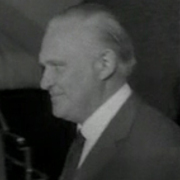
Michael Forlong
Michael Forlong began his prolific filmmaking career in his native New Zealand, but from the mid-50s on, worked largely in England.
Born in Whanganui on 20 March 1912, Forlong was brought up largely by his mother. Forlong was an announcer on Wellington radio station 2ZB when he was drafted to write the script for an ambitious Government film, marking New Zealand’s 1940 centennial. Originally running at roughly 53 minutes, One Hundred Crowded Years mixed Waitangi re-enactments with modern day doco footage. Ultimately the filmwould win its biggest audiences from school groups. Forlong also worked on at least three other films for the NZ Government, before serving in WWII.
In 1944 Forlong joined recently created Government filmmaking body the National Film Unit, where he began writing and editing for NFU newsreel Weekly Review. Forlong would go on to direct (plus usually write and edit) an impressive tally of 25 plus films at the Unit.
With few exceptions, filmmaking commissioned for the NZ Government had long been based mainly around newsreels and promotional films. Though Forlong worked on his fair share of Weekly Review newsreels, a number of his more noteworthy films incorporated dramatic elements.
The Elysian Bus added celestial stylings to its road safety message, complete with angels; rare NFU drama Aroha, which includes classic tune ‘Blue Smoke’, told the story of a young Māori woman facing conflict over traditional and Western forms of medical treatment. The 18-minute film may have been given the go-ahead as an attempt to head off independently-made feature film Broken Barrier (1952) which also told a rare (though ultimately very different) Māori-Pākehā story.
Forlong also ventured into dance and the experimental with a 1948 Weekly Review newreel which lived up to its title (Rhythm and Movement). Some viewers found the film’s innovation - and partial nudity - a bridge too far.
By now Forlong had began investigating filmmaking opportunities overseas. In 1949, while working in Australia as an assistant director on aborigine tale Bitter Springs, he won a British Council scholarship; and it was in England that he recut his 45-minute long NFU drama-doco Journey for Three for its British release.
In Europe, the second stage of Forlong’s filmmaking career began. He made his feature debut in 1954 as director and co-writer of Shetlandsgjengen (released in America as Suicide Mission). The film recreated the real-life WWII exploits of The Shetland Bus, which saw Norwegian fishermen sneaking refugees from German-occupied Norway to the Shetland Islands.
Forlong drafted many real-life sailors to play themselves, including Shetland Bus skipper Leif Larsen, the most decorated naval officer of WWII. By coincidence Shetlandsgjengen was made the same year as Child’s Play, the first and only feature film directed by Margaret Thomson, another expat Kiwi who had spent time at the NFU.
Forlong was also second unit director on the Spanish shoot of Richard Burton epic Alexander the Great (1956), and assisted Ealing Studios legend Michael Balcon on the production of WWII epic Dunkirk.
During the 60s Forlong returned to directing with a vengeance. That decade he made five features, including two comedies and roving race car drama The Green Helmet, in which Carry On star Sid James attempts to channel a strine accent. One of them, forgotten plantation drama Plantage Tamarinde, was shot in Dutch, largely in the Dutch Antilles.
In 1968 Forlong made the first of five films for UK organisation The Children’s Film Foundation. Since 1951 the CFF had utilised a tax on movie tickets to fund “clean, healthy, intelligent” hour-long films for children. Lionheart was the tale of a boy (played by the director’s son James) who befriends an escaped lion.
As rising budgets allowed the CFF to shoot beyond the UK, Forlong won the opportunity to write and direct a story set in New Zealand. Rangi’s Catch (completed in 1972) was the tale of four children playing hide and seek across the country with two escaped criminals (one of them played by Ian Mune). A 12-year-old Temuera Morrison made his debut as Rangi, after Forlong spotted him in Rotorua doing kapa haka and a welcome speech for tourists.
Originally shot in eight parts for television, Rangi’s Catch was recut for release in New Zealand as a movie. Reaction was generally upbeat, with Dominion reviewer Catherine de la Roche labelling it "one of the best children's films ever made".
Forlong’s last feature was CFF tale High Rise Donkey (1980), written by Ealing Studios scribe TEB Clarke. He continued to direct corporate films until at least 1985. Ian Percival Michael Forlong passed away in Spain in 2000.
Sources include
Clive Sowry
John O’Shea, ‘A Charmed Life: Fragments of Memory..and Extracts from Conversations’ in Film in Aotearoa New Zealand. Editors Jonathan Dennis and Jan Bieringa (Wellington: Victoria University Press, Second Edition 1996)
William Renwick, ‘One Hundred Crowded Years: The Centennial Film,’ in Creating a National Spirit: Celebrating New Zealand’s Centennial. Editor William Renwick (Wellington: Victoria University Press, 2004)
Andrew Roberts, ‘How the Children’s Film Foundation once dominated Saturday morning cinema’ - Guardian, 9 September 2010
‘Michael Forlong’, The Internet Movie Database website. Accessed 9 February 2016